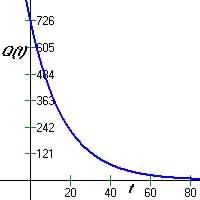At end of 1st year: 100% + 1.9% = 101.9%
P = 70(1.019)
At end of 2nd year:
P(1.019)(1.019) = 70(1.019)2
At end of 3rd year:
P(1.019)(1.019)(1.019) = 70(1.019)3
At end of t-th year:
P = 70(1.019)t
Given: growth at rate of 28% per decade
Then r = 0.28
Growth factor is the (1 + r) = 1 + 0.28 = 1.28
The rate of decay is 5.626% / year so growth factor is 1 - 0.05626 = 0.94374
Since exponential decreasing functions, a general formula is 
(a) So formula is 
(b) A graph of the function is

Given: 500 items, increase by 42% then decrease by 42%.
Ans.: 411.8
Since 42% increase yields: 500 (1.42) = 710
And 42% decrease yields: 710(1 - 0.42)
= 710(0.58) = 411.8
Lesson 8 - 3.1#19 Study of exponential decreasing function (caffeine elimination at 16% per hour).
(a) Since C0 = 100 mg, Ct = 100(1-0.16)t

(b) If C is amount of caffeine in body each hour after consumption, then C = 41.821 mg when t = 5 hours.
Since 








